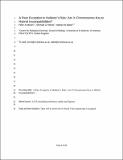Files in this item
A rare exception to Haldane's rule: are X chromosomes key to hybrid incompatibilities?
Item metadata
| dc.contributor.author | Moran, Peter | |
| dc.contributor.author | Ritchie, Michael Gordon | |
| dc.contributor.author | Bailey, Nathan William | |
| dc.date.accessioned | 2017-07-18T10:30:12Z | |
| dc.date.available | 2017-07-18T10:30:12Z | |
| dc.date.issued | 2017 | |
| dc.identifier | 249668156 | |
| dc.identifier | 7f2d5668-2d8c-436b-b8ed-dcec094003db | |
| dc.identifier | 85009781838 | |
| dc.identifier | 28098850 | |
| dc.identifier | 000401023700006 | |
| dc.identifier.citation | Moran , P , Ritchie , M G & Bailey , N W 2017 , ' A rare exception to Haldane's rule: are X chromosomes key to hybrid incompatibilities? ' , Heredity , vol. 118 , no. 6 , pp. 554-562 . https://doi.org/10.1038/hdy.2016.127 | en |
| dc.identifier.issn | 0018-067X | |
| dc.identifier.other | ORCID: /0000-0001-7913-8675/work/46761118 | |
| dc.identifier.other | ORCID: /0000-0003-3531-7756/work/60888413 | |
| dc.identifier.uri | https://hdl.handle.net/10023/11234 | |
| dc.description | This work was funded by NERC (NE/G014906/1, NE/L011255/1, NE/I027800/1). Additional funding from the Orthopterists’ Society to PM is also gratefully acknowledged. | en |
| dc.description.abstract | The prevalence of Haldane’s rule suggests that sex chromosomes commonly have a key role in reproductive barriers and speciation. However, the majority of research on Haldane’s rule has been conducted in species with conventional sex determination systems (XY and ZW) and exceptions to the rule have been understudied. Here we test the role of X-linked incompatibilities in a rare exception to Haldane’s rule for female sterility in field cricket sister species (Teleogryllus oceanicus and T. commodus). Both have an XO sex determination system. Using three generations of crosses, we introgressed X chromosomes from each species onto different, mixed genomic backgrounds to test predictions about the fertility and viability of each cross type. We predicted that females with two different species X chromosomes would suffer reduced fertility and viability compared with females with two parental X chromosomes. However, we found no strong support for such X-linked incompatibilities. Our results preclude X–X incompatibilities and instead support an interchromosomal epistatic basis to hybrid female sterility. We discuss the broader implications of these findings, principally whether deviations from Haldane’s rule might be more prevalent in species without dimorphic sex chromosomes. | |
| dc.format.extent | 9 | |
| dc.format.extent | 523641 | |
| dc.language.iso | eng | |
| dc.relation.ispartof | Heredity | en |
| dc.subject | Sex chromosomes | en |
| dc.subject | Large X effect | en |
| dc.subject | Dominance | en |
| dc.subject | Female sterility | en |
| dc.subject | Teleogryllus | en |
| dc.subject | QH301 Biology | en |
| dc.subject | QH426 Genetics | en |
| dc.subject | DAS | en |
| dc.subject.lcc | QH301 | en |
| dc.subject.lcc | QH426 | en |
| dc.title | A rare exception to Haldane's rule: are X chromosomes key to hybrid incompatibilities? | en |
| dc.type | Journal article | en |
| dc.contributor.sponsor | NERC | en |
| dc.contributor.sponsor | NERC | en |
| dc.contributor.sponsor | NERC | en |
| dc.contributor.institution | University of St Andrews. School of Biology | en |
| dc.contributor.institution | University of St Andrews. Centre for Biological Diversity | en |
| dc.contributor.institution | University of St Andrews. Institute of Behavioural and Neural Sciences | en |
| dc.identifier.doi | https://doi.org/10.1038/hdy.2016.127 | |
| dc.description.status | Peer reviewed | en |
| dc.identifier.grantnumber | NE/G014906/1 | en |
| dc.identifier.grantnumber | NE/L011255/1 | en |
| dc.identifier.grantnumber | Ne/I027800/1 | en |
This item appears in the following Collection(s)
Items in the St Andrews Research Repository are protected by copyright, with all rights reserved, unless otherwise indicated.

